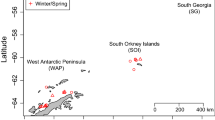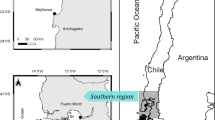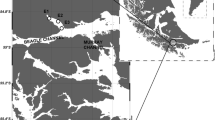Abstract
C25 highly branched isoprenoids (HBIs) are produced by a relatively small number of diatom species, yet are common constituents of almost all marine environments. Previously, detection of HBIs in a few aquatic Arctic animals has indicated the potential use of these lipids for providing novel ecological information. In the current study, analysis of lipid extracts of livers from Leach’s storm petrel (Oceanodroma leucorhoa) and Brunnich’s guillemot (Uria lomvia) facilitated identification and quantification of HBI isomers. HBIs were found in the tissues of all specimens with clear differences in the abundances and distributions of individual HBI isomers both between Atlantic as well as Arctic birds. These differences are consistent with contrasting oceanographic regimes and suggests that regional differences in HBIs are reflected in the tissues of consumers. Tissue-specific assessment of HBI distributions has also revealed the presence of these lipids in muscle for the first time. This study represents the first report of HBI lipids in birds and provides evidence that these lipids are transferred across trophic levels and extends their potential use as chemical tracers beyond the ecology of aquatic organisms.



Similar content being viewed by others
References
Belt ST, Allard WG, Massé G, Robert JM, Rowland SJ (2000) Highly branched isoprenoids (HBIs): Identification of the most common and abundant sedimentary isomers. Geochim Cosmochim Ac 64:3839–3851. doi:10.1016/S0016-7037(00)00464-6
Belt ST, Brown TA, Navarro-Rodriguez A, Cabedo-Sanz P, Tonkin A, Ingle R (2012) A reproducible method for the extraction, identification and quantification of the Arctic sea ice proxy IP25 from marine sediments. Anal Methods 4:705–713
Belt ST, Massé G, Allard WG, Robert JM, Rowland SJ (2001) Identification of a C25 highly branched isoprenoid triene in the freshwater diatom Navicula sclesvicensis. Org Geochem 32:1169–1172
Belt ST, Massé G, Rowland SJ, Poulin M, Michel C, LeBlanc B (2007) A novel chemical fossil of palaeo sea ice: IP25. Org Geochem 38:16–27
Belt, ST, Müller, J (2013) The Arctic sea ice biomarker IP25: A review of current understanding, recommendations for future research and applications in palaeo sea ice reconstructions. Quaternary Science Reviews. doi:10.1016/j.quascirev.2012.12.001
Belt ST, Vare LL, Massé G, Manners H, Price J, MacLachlan S, Andrews JT, Schmidt S (2010) Striking similarities in temporal changes to seasonal sea ice conditions across the central Canadian Arctic Archipelago during the last 7,000 years. Quat Sci Rev 29:3489–3504
Bicknell AWJ, Knight ME, Bilton D, Reid JB, Burke T, Votier SC (2012) Population genetic structure and long-distance dispersal among seabird populations: implications for colony persistence. Mol Ecol 12:2863–2876
Brown TA, Belt ST (2012a) Identification of the sea ice diatom biomarker IP25 in Arctic benthic macrofauna: direct evidence for a sea ice diatom diet in Arctic heterotrophs. Polar Biol 35:131–137
Brown TA, Belt ST (2012b) Closely linked sea ice–pelagic coupling in the Amundsen Gulf revealed by the sea ice diatom biomarker IP25. J Plankton Res 34:647–654
Brown TA, Belt ST, Philippe B, Mundy CJ, Massé G, Poulin M, Gosselin M (2011) Temporal and vertical variations of lipid biomarkers during a bottom ice diatom bloom in the Canadian Beaufort Sea: further evidence for the use of the IP25 biomarker as a proxy for spring Arctic sea ice. Polar Biol 34:1857–1868
Brown TA, Belt ST, Piepenburg D (2012) Evidence for a pan-Arctic sea-ice diatom diet in Strongylocentrotus spp. Polar Biol 35:1281–1287
Brown TA, Belt ST, Ferguson SH, Yurkowski DJ, Davison NJ, Barnett JEF, Jepson PD (2013) Identification of the sea ice diatom biomarker IP25 and related lipids in marine mammals: A potential method for investigating regional variations in dietary sources within higher trophic level marine systems. J Exp Mar Biol Ecol 441:99–104. http://dx.doi.org/10.1016/j.jembe.2013.01.020
Gaston AJ, Gilchrist HG, Hipfner JM (2005) Climate change, ice conditions and reproduction in an Arctic nesting marine bird: Brunnich’s guillemot (Uria lomvia L.). J Anim Ecol 74:832–841
Hedd A, Montevecchi WA (2006) Diet and trophic position of Leach’s storm-petrel Oceanodroma leucorhoa during breeding and moult, inferred from stable isotope analysis of feathers. Mar Ecol-Prog Ser 322:291–301
Massé G, Rowland SJ, Sicre M-A, Jacob J, Jansen E, Belt ST (2008) Abrupt climate changes for Iceland during the last millennium: evidence from high resolution sea ice reconstructions. Earth Planet Sci Lett 269:565–569
Rowland SJ, Belt ST, Wraige EJ, Masse G, Roussakis C, Robert JM (2001) Effects of temperature on polyunsaturation in cytostatic lipids of Haslea ostrearia. Phytochemistry 56:597–602
Acknowledgments
The authors would like to thank Plymouth University and the Seale Hayne Educational Trust for project funding. We also thank Greg Robertson at Canada Wildlife Services, Newfoundland for supplying the LSPs from the Canadian wreck and members of the public that kindly sent in corpses found in the UK. We are also grateful to Stig Falk-Petersen and the captain and crew of the R/V Helmer Hanssen and in particular Jorgen Berge for assistance in obtaining Brunnich’s guillemots. We also acknowledge the helpful comments of two anonymous reviewers.
Author information
Authors and Affiliations
Corresponding author
Rights and permissions
About this article
Cite this article
Brown, T.A., Bicknell, A.W.J., Votier, S.C. et al. Novel molecular fingerprinting of marine avian diet provides a tool for gaining insights into feeding ecology. Environ Chem Lett 11, 283–288 (2013). https://doi.org/10.1007/s10311-013-0402-x
Received:
Accepted:
Published:
Issue Date:
DOI: https://doi.org/10.1007/s10311-013-0402-x




